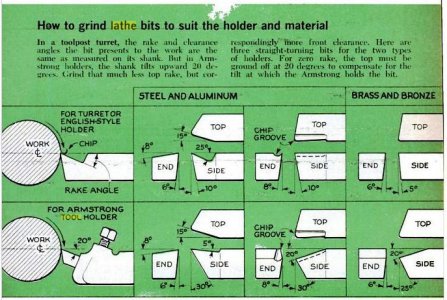My Atlas 618 came with a lantern tool post, but the concave washer was broken. There was a carbide tool bit (3/8" square shank) in the lantern post, with some large flat washers fitted over the post under the bit, raising it to the correct height and supporting it quite solidly, but holding it dead horizontal. I took that as an example of how I might proceed with some new HSS bits, as the dozens of carbide bits that came with the lathe all seemed chipped. I didn't know anything of back rake or of the Armstrong type tool holders at that time...
As a complete novice to metal lathe work as of maybe eight lathe-operating-hours ago, I ground a couple 3/8" square 5% cobalt HSS tool bits per Tubalcain on Youtube, and they could cut about .010" to .015" per pass from oiled mild steel, under ideal conditions, and generate a fair amount of oil smoke.
But now I see in the SBL book, _How To Run A Lathe_, that for mild steel it specifies using the Armstrong Williams type tool holders, which add 16.5 degrees back rake to the tools, and presumably remove 16.5 degrees of front clearance. And it shows in Figure 56 a front clearance of 3 to 15 degrees, after back rake is accounted for.
Then to complicate it further, I see in the Tubalcain video he specifies (video #1, 4:24) the use of the tool holders that add 16.5 degree back rake, which I have not done, using my tools flat, but ground to his specs...
And it seems many guys use tool holders that hold the tool flat level (as I have done) and don’t add any back rake, let alone 16.5 degrees! Instructions I've found on grinding tools mostly don't specify if they are grinding tools for horizontal tool holders or 16.5 degree back rake tool holders, except for the SBL book and Tubalcain.
With all the emphasis on the importance of exact tool geometry, I must be missing something huge.
Is there some standard reference that differentiates between grinding tools for use with 16.5 degree back rake holders vs no back rake holders?
Is the Sherline instruction good basic geometry for a tool with no holder-induced back rake? I notice, in Figures 10 A & B, he specifies not making the "usual" pronounced hook, which is the same as minimizing back rake, and which he says is a good compromise of minimal lost cutting performance versus easier sharpening...
It seems maybe back rake was over-rated in the old school methods? Or, does back rake give a more slicing and less scraping cutting tendency that may be more important to larger lathes taking a deeper cut, or production versus hobby applications? Very interested to know.
Any discussion, comments or advice on this would be most welcome.
“Education: the path from cocky ignorance to miserable uncertainty.”
― Mark Twain
As a complete novice to metal lathe work as of maybe eight lathe-operating-hours ago, I ground a couple 3/8" square 5% cobalt HSS tool bits per Tubalcain on Youtube, and they could cut about .010" to .015" per pass from oiled mild steel, under ideal conditions, and generate a fair amount of oil smoke.
But now I see in the SBL book, _How To Run A Lathe_, that for mild steel it specifies using the Armstrong Williams type tool holders, which add 16.5 degrees back rake to the tools, and presumably remove 16.5 degrees of front clearance. And it shows in Figure 56 a front clearance of 3 to 15 degrees, after back rake is accounted for.
Then to complicate it further, I see in the Tubalcain video he specifies (video #1, 4:24) the use of the tool holders that add 16.5 degree back rake, which I have not done, using my tools flat, but ground to his specs...
And it seems many guys use tool holders that hold the tool flat level (as I have done) and don’t add any back rake, let alone 16.5 degrees! Instructions I've found on grinding tools mostly don't specify if they are grinding tools for horizontal tool holders or 16.5 degree back rake tool holders, except for the SBL book and Tubalcain.
With all the emphasis on the importance of exact tool geometry, I must be missing something huge.
Is there some standard reference that differentiates between grinding tools for use with 16.5 degree back rake holders vs no back rake holders?
Is the Sherline instruction good basic geometry for a tool with no holder-induced back rake? I notice, in Figures 10 A & B, he specifies not making the "usual" pronounced hook, which is the same as minimizing back rake, and which he says is a good compromise of minimal lost cutting performance versus easier sharpening...
It seems maybe back rake was over-rated in the old school methods? Or, does back rake give a more slicing and less scraping cutting tendency that may be more important to larger lathes taking a deeper cut, or production versus hobby applications? Very interested to know.
Any discussion, comments or advice on this would be most welcome.
“Education: the path from cocky ignorance to miserable uncertainty.”
― Mark Twain


